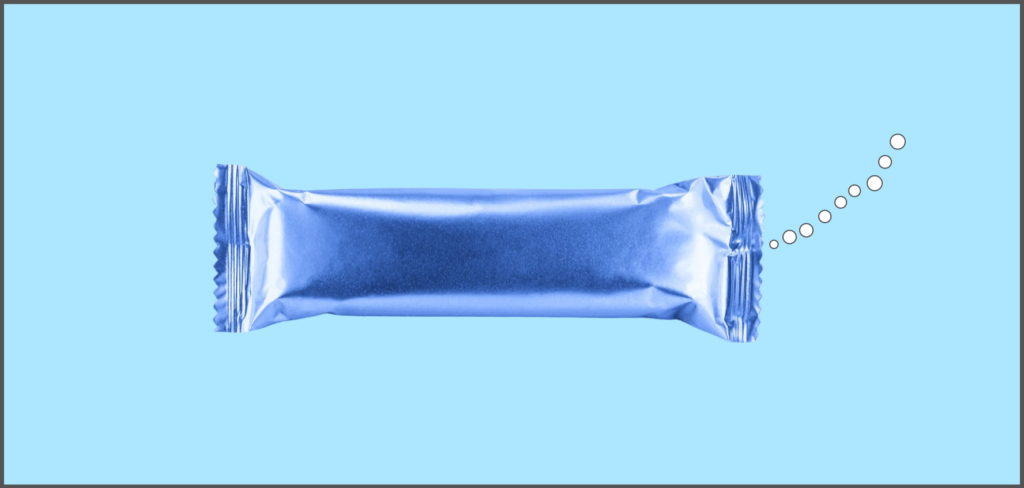Before you can determine the best seal test for your flexible packaging products, you need to clearly identify your requirements for seal strength and hermiticity. Then you can use these criteria to evaluate different methods and to accurately interpret test results.
This Greener Tech Bite explains the objectives, methods, results, and limitations of seven common seal tests for packages produced by flow wrappers and vertical baggers. We begin with seal strength tests, followed by tests for hermeticity, and conclude with a summary chart for easy comparison.

1. Peel Strength Test
Objectives: Peel Strength Tests measure seal strength, the ability of a package to remain sealed when subject to tension.
Methods: Seals are produced on a lab sealer at a series of different temperatures, with pressure and dwell time remaining constant. A testing device measures the force required to peal each seal apart.

Results: The force required to peel a unit width of seal is correlated with sealing temperature to compare the seal strength of one packaging material against another, or against historical data.

Limitations: Set points for temperature, pressure, and dwell time are typically standardized to ensure repeatability and inter-lab correlatability. They don’t necessarily represent production settings and therefore don’t indicate real-world results.
Sometimes seals are tested by pulling them apart by hand. This method does not produce repeatable Peel Strength results, though a seal that fully delaminates across the package width indicates seal strength that exceeds the material’s tear resistance.

2. Hot Tack Test
Objectives: Hot Tack Tests measure the strength of a seal while still warm.
Methods, Results, & Limitations: Test methods, results, and limitations are very similar to peel strength tests, except force is applied instantaneously, before the seal can cool.

3. Burst Resistance Test
Objectives: Burst Resistance Tests measure the pressure required to burst a package.
Methods: An unrestrained package is inflated until the internal pressure causes seal failure.


Results: Burst pressure values are often used to evaluate the effects of elevational pressure changes when packages are shipped.
Limitations: Since outcomes depend on package size and geometry—a given pressure level generates greater force across a wider package—Burst Resistance Tests don’t provide easily comparable values for seal strength.
4. Water Vacuum (Bubble) Test
Objectives: The Water Vacuum Test identifies the presence and location of leaks and is also used to assess leaks caused by pressure changes during shipping.
Methods: Packages are held under water in a sealed tank, where a vacuum is drawn. Bubbles appear when air inside the package is forced through leaks from higher to lower pressure.
Packages may also be squeezed under water by hand to look for bubbles.

Results: The presence of bubbles provides visible evidence of leaks and their location.
Limitations: Water Vacuum Tests don’t accurately measure leak size, since results are influenced by the initial air fill, size, and geometry of the package. Initial air fill must also be considered when assessing the impact of pressure changes during shipment.


Since the manual squeeze test is not accurately repeatable, results can be inconsistent.
5. Dye Leak Test
Objectives: Dye leak tests can also indicate the presence and location of leaks.
Methods: Colored dye is injected into the package, which is held for a set time with the seal oriented horizontally at the bottom and then inspected.



Results: Leaks are indicated by places where the dye has migrated through the seal.
Limitations: The Dye Leak Test tends to be less sensitive for smaller leaks and doesn’t quantify the magnitude of leaks.

6. Pressure Decay Test
Objectives: Pressure Decay tests measure both the presence and the magnitude of leaks.
Methods: A package is inserted into chamber, where a vacuum is drawn that pressurizes the package. If leaks are present, air is forced from the package into the chamber and the vacuum pressure decays.
Older pressure decay methods don’t use a chamber or create a vacuum, but instead inject air to achieve pressurization.

Results: Reductions in pressure indicate leaks; the rate of reduction reflects the size and overall magnitude of the leaks.
Limitations: With older Pressure Decay testing devices, the pressurized package will expand in volume. Excessive pressurization may result in seal creep or stretching and skew results. This limits the maximum seal test pressure, especially as package size increases.
The newest devices resolve these issues by restraining the package in a flexible bladder that prevents the pressurized package from expanding, allowing much higher pressures to be used.

Since the natural pressure decay rate decreases as pressure decreases, as illustrated on this graph, results from this test method are more precise for smaller leaks and lose accuracy as leak sizes increase.

7. Gas Flow Detection Test
Objectives: Gas Flow Detection Tests also measure the presence and magnitude of leaks.
Methods: A package is inflated or evacuated with a needle probe; the device monitors the gas flow required to maintain a set pressure level.
Results: Any gas flow required to maintain a given pressure indicates the presence and magnitude of leaks.

Limitations: Since pressure levels produced by Gas Flow Detection devices are limited, accuracy is best for medium to larger sized leaks.

Summary Chart: Seven Seal Testing Methods for Flexible Packaging
This summary chart will help you compare all seven seal tests for flexible packaging on your flow wrappers and vertical FFS baggers.
If you’d like help defining your sealing objectives and evaluating seal testing methods, contact Greener Corporation. We provide package quality and productivity solutions worldwide.



